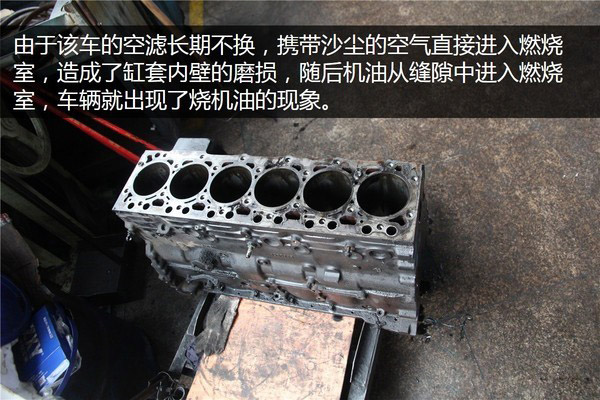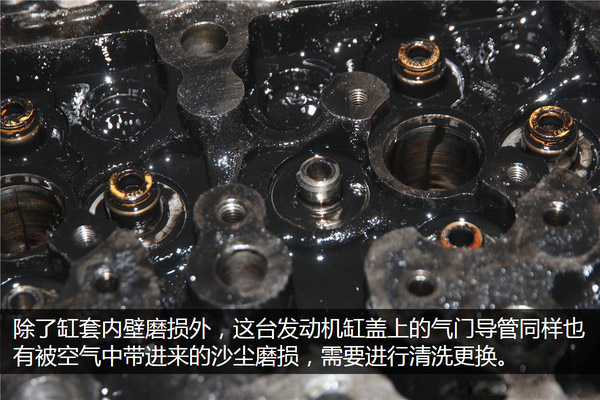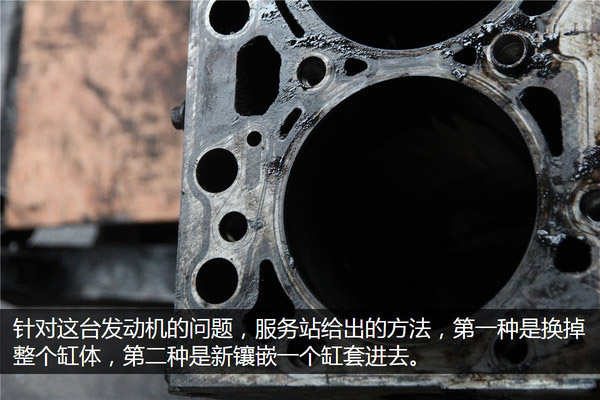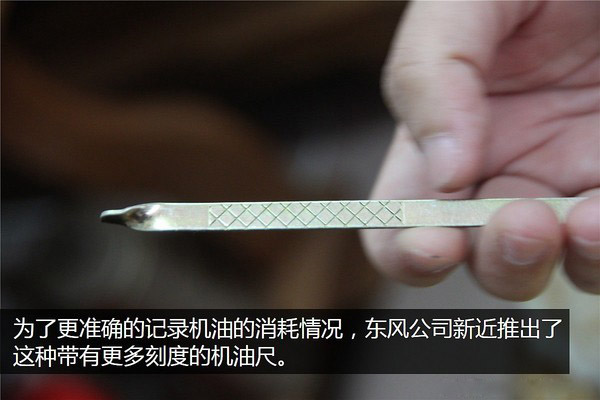Burning oil means that the oil enters the combustion chamber of the engine and participates in combustion with the mixture, causing the oil to be consumed too quickly. Because of the complexity of the causes of burning oil, the harm caused is also of a different size. It has always been a major problem for drivers and maintenance personnel. With the maintenance case encountered at the service center in Dongfeng Guangzhou, we discussed the various causes and methods of identifying the engine oil. â— The air filter is not diligent and causes the inner wall of the engine cylinder liner to wear out Today, the author encountered this engine in maintenance at the Dongfeng Guangzhou Center Service Station. The Dongfeng Cummins D-Series engine has a power of 245 horsepower and is mounted on a Dongfeng Tianlong 6x2 truck. According to the on-site maintenance master, the problem with this engine is on the inner wall of the liner. Due to the failure of air filter replacement or air intake pipe leakage, the air enters the engine without air filtering, and the large particles are trapped in the cylinder, which wears the cylinder wall during the continuous movement of the piston. The oil enters the combustion chamber with the gap in the cylinder wall, causing the phenomenon of burning oil. In addition to the wear of the inner wall of the cylinder liner, the Valve guide on the Cylinder Head of this engine also has dust wear brought in by the air and needs to be replaced because the D Series Cummins engine cylinder and cylinder are integrated and the cylinder liner cannot Take it out separately, so it will need to remove the whole engine when it needs to change the cylinder liner. The way to dismantle the engine in this type of engine repair will be higher than other engines in terms of maintenance cost. Due to the integrated design of Kang Busi D-Series engines and cylinders, there are two types of maintenance programs at the service station. The first one is to replace the entire cylinder and the other is to insert a new cylinder on the original basis. Go in. â— Reasons for Burning Oil and Its Causes With the continuous improvement of the concept of vehicle maintenance by drivers, it is actually not common to replace the inconvenience caused by air filter or the case of burning oil caused by the air intake pipe leakage. Dongfeng Guangzhou Central Station recently tracked many problems with Renault engine oil burning. According to the person in charge of the service station, this type of new car carrying Renault machines will generally carry out the first insurance after traveling 1500-2500 km, and 8000 -For the first 10,000 kilometers, you need to change the first oil. Because during the running-in period, the engine generates a lot of metal powder during operation, and if it is not replaced on time, the metal powder is likely to generate carbon stuck piston rings after combustion, which is why most Renault engines burn oil. Although manufacturers have specific requirements for vehicle mileage, the actual implementation is not optimistic because many users do not perform mileage maintenance as required after the first insurance. There are many delays in the mileage. Drivers who ran dangerously dangerous transportation felt that they were usually lighter. After the first insurance, they did not change oil after 50,000 kilometers. In addition, according to the reaction of the forum card friends, Renault machines often use exhaust brakes, and they also have a phenomenon of burning oil. This card friend opened the Renault 340's Tianlong, and the previous cycle had 20,000 kilometers to add 2 liters of oil, because The total weight of the overloaded vehicle is 80T. The average fuel consumption is 40 (half of each empty and heavy vehicle). That is, burning 8,000 liters of diesel will burn 2 liters of oil, which is a very normal proportion of oil loss. He had not used exhaust brakes in the most recent period, and there was no less than 10,000 kilometers of engine oil. From this, he came to the conclusion that the exhaust brake will be opened, the oil will lose a little bit more, and there will be a little oil seepage between the engine's valve cover and the cylinder head, and now no exhaust brake will not leak. â— How to determine whether the burning oil exhaust gas is blue smoke/oil dipstick to measure the oil consumption rate Judging from the outside whether the vehicle burns oil can be distinguished from the following two phenomena. Phenomenon I. The main performance of burning oil is to emit blue exhaust gas at the tail when driving, which means that too much oil enters the combustion chamber to participate in combustion. In phenomenon two, the oil dipstick detects excessive oil consumption. In order to record in detail the amount of oil burned by the vehicle, Dongfeng also specially designed a new oil dipstick to help service stations and drivers better solve this problem. â— Burning oil is a common cause of failure 10 major incentives The consumption of diesel engine oil is a common fault of the automobile. The cause of excessive oil consumption is usually caused by the poor sealing of piston Connecting Rod group, gas distribution mechanism, Cylinder Block, excessive oil filling, leakage, etc. . Ten kinds of specific performances, judgments, and checks can be listed. (1) External leakage External leakage of oil is often caused by tubing rupture, damage to seals or oil seals, loosening of fastening nuts, etc. Possible locations of external leakage include engine outer tubing, oil pan seals, cylinder head gaskets, valve chamber cover seals, gear cover gaskets, crankshaft front and rear oil seals, and oil filters. As long as there are traces of leakage from the outside, it will lead to a high oil consumption rate, so any possible source of leakage should not be ignored. (very common failure) (2) Excessive crankcase oil The oil level in the crankcase is too high, and the crankshaft's connecting rod end splashes excessive oil on the cylinder wall. This excess oil enters the combustion chamber when the engine is working, which increases the consumption of oil. When checking the oil level, special attention should be paid to the dipstick reticle and the correct method of measuring the sump oil level. (Masters should not have such problems) (3) Blocking of the return passage of the piston ring The use of lubricants with low additive content, long-term low-temperature operation of the engine or improper oil change, improper maintenance of the oil filter, dirtying the lubricant, etc. will block the return oil passages of the piston ring and ring groove. Excess oil on the cylinder wall can not be returned to the crankcase, but burn into the combustion chamber to form a coke. In addition, dirty oil will also clog the drain hole of the cylinder head of the engine. At this time, the oil will overflow the popular door guide and increase the consumption of oil. (The failure of most new cars to replace oil in the run-in period will cause such failures.) (4) Abnormal wear of piston rings, cylinder liners and pistons If the user overloads during use, the engine will be overloaded. At this time, pistons and piston rings working above normal temperature will cause the piston ring to break or snap in the ring groove, and its tension will weaken or even lose tension. Poor sealing at the edge of the intake pipe seal and failure of the air filter can also cause external foreign materials and dust to enter the combustion chamber, causing early wear of the cylinder liner, piston, and ring. (This engine burning oil in the article belongs to this kind of situation) When the piston ring and the piston ring groove wear excessively, the piston ring appears in the ring groove to pump oil to the top of the piston during the up and down movement of the piston. The oil will be sent into the combustion chamber during the intake stroke, which will burn the oil on the cylinder, piston and piston ring to form carbon deposits. By checking the cylinder pressure of the engine, the airtightness of the cylinder can be judged. If the cylinder pressure is insufficient, and the cylinder pressure is significantly increased after adding the engine oil around the piston, the air leakage of the cylinder can be determined. This may be caused by the abnormal wear of the cylinder and the piston. In this case, open the cylinder head as appropriate. After abnormal wear of the piston, piston rings and cylinder liners, the engine will be exposed to exhaust under the burning oil. The piston ring is broken and there will be abnormal sound when the engine is working. It should be replaced in time. (5) Cylinder deformation The fit clearance between the piston and the cylinder sleeve is acceptable and the oil can be controlled by the piston and the piston ring. However, if the cylinder sleeve has taper and roundness, oil control becomes difficult. When the gap between the piston and cylinder liner is too large, the piston will oscillate within the cylinder; at the moment of tilt, there will be too much oil entering the piston ring from one side of the piston. When the piston returns after each stroke, organic oil enters the combustion chamber. (6) Supercharger leak In case of incorrect use, the user will damage the supercharger shaft and bearing, so that the sealing performance of the supercharger poise seal will be ineffective. The oil will crash into the intake pipe and enter the cylinder to burn, causing the engine exhaust to emit blue smoke and burning oil; Remove the turbocharger outlet will find organic oil on the inner wall of the rubber tube. For supercharged, supercharged and intercooled engines, they should be idling for at least 5 minutes before starting and they should be idle for at least half a minute before stopping to stop the engine. This can prevent the turbocharger from being damaged due to lack of oil. (7) Air filter plugging Blockage of the air filter can lead to poor air intake and reduce the pressure of the intake air to form a negative pressure, which causes the oil to be drawn into the combustion chamber under negative pressure to cause burning of oil. (8) Damaged or missing valve seal The valve oil seal on the engine controls the oil flow of the valve guide. If the valve seal is damaged or if it is missed during the warranty period, the oil will enter the combustion chamber along the valve guide and cause the oil consumption to increase linearly. The unburnt oil will enter the exhaust passage and be discharged with the high temperature exhaust gas. Therefore, the valve oil seal should be checked and properly installed during the warranty period. (9) Loss of respirator or oil gas barrier If there is a metal partition or oil-gas baffle in the cylinder cover, if it is lost, the oil mist in the crankcase will not be able to escape directly through the engine respirator hose, and the oil in the oil pan will evaporate to form an oil mist. In this way, the amount of oil in the oil pan will quickly decrease. (10) Air pump oil The pump works like the engine. The inspection method for the air pump oil is to remove the air pump outlet pipe after the engine is started, and observe whether organic oil is pumped out from the air pump outlet port at this time. â— Postscript There are various causes of excessive oil consumption. External leakage, engine running-in, engine type, etc. may cause loss of engine oil. However, regular maintenance, routine maintenance, and inspection of vehicles are used to select better-quality diesel oil, engine oil, etc. Methods can reduce or avoid this risk. It is hoped that the card readers will finish this article and can strengthen the ability to discriminate and cope with the high oil consumption of vehicles. Cylinder Block Cylinder Block,Portable Scuba Air Compressor,Small Gasoline Powered Air Compressor,Portable Diving Compressor Permanent Machinery Co., Ltd. , https://www.hjjxcompressor.com





